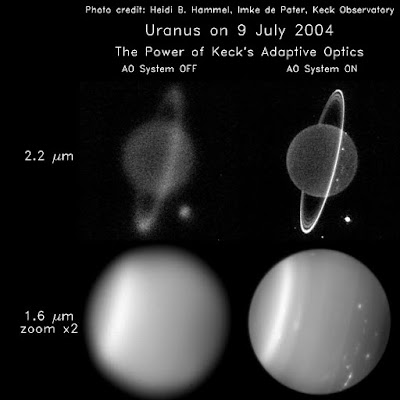inside UKIRT's control room, there is a screen showing the realtime view from an all-sky camera! the image below shows that view... you can see the telescope on the left side and the milky way galaxy streaming across the sky!

the green plus sign is where our telescope is pointing and the little yellow crosshairs show the position of a companion telescope. at the upper left, above the white telescope, you can see a fainter silver dome with a big line shooting out of it! that is the laser used by the gemini telescope adaptive optics system. the laser is clearly visible when i go outside, and i think its great fun to watch it change positions!
so what are adaptive optics and why do we shoot lasers into the sky??
because photons of light from distant stars get shaken up as they pass thru the earth's atmosphere, causing them to "twinkle" to our eyes. the more the photons get shaken up, the bigger and "fuzzier" objects appear in a telescopic image (this is the major advantage of putting telescopes in space). if we can somehow determine the turbulence in the atmosphere as the photons pass thru it, we can correct for it and get sharper images of the stars!
adaptive optics is a fascinating technique that has recently come in to use by several major telescopes around the world to improve the image sharpness. to correct for atmospheric distortions, you use a specific guide star, a quick computer to measure how the star "twinkles", and a special deformable mirror that sits inside the optical path of the telescope.
the computer measures the changing light coming from the guide star every millisecond or less, then rapidly sends signals to adjust the shape of the special mirror in order to immediately correct for the "twinkle." if there is no natural guide star bright enough to use in the part of the sky that you happen to be observing, you can create an artificial guide star with a laser! a "laser guide star" it's called.
here's a nice example of how impressively the use of adaptive optics can improve image quality!

pretty amazing difference, no? adaptive optics systems are incredibly complicated to develop and produce, so not all telescopes use them, but they become more important as telescope mirror sizes increase.
now to go check the sky....
5 comments:
Wow, that is a serious difference!
Could you use the same technology to keep party pictures in focus when I'm too shattered to hold the iPhone steady? ;)
Very interesting; thanks for the explanation! If it doesn't get too technical, can you explain how they change the shape of the mirror? I thought the mirrors were large pieces of highly polished material set into a parabolic bowl, and I have a hard time imagining them changing shape. Please forgive if this appears to be a stupid question---I'm a total layman!
haha - thats funny, creed! i wish!
rick - thats a good point. no, they dont change the shape of the big primary mirror... they add in a smaller mirror to the system that can be be adjusted rapidly with actuators. here's an example of one:
http://www.ctio.noao.edu/~atokovin/tutorial/part2/keck_dm.jpg
that is really interesting! it is amazing the difference it makes!
I once thought the VLT couldn't compare with the HST, but now I don’t think so.
Post a Comment